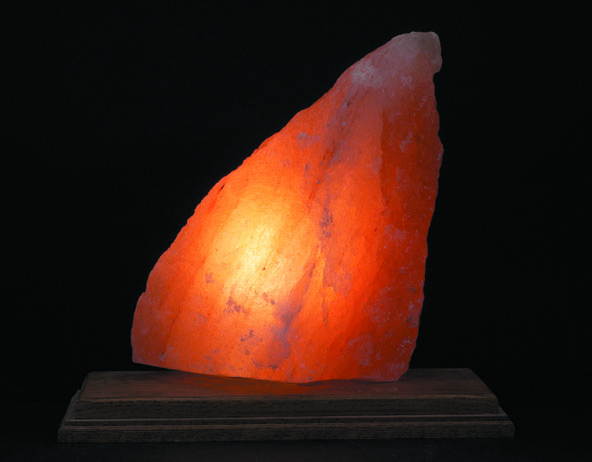When Himalayan salt lamps are lit up, they diffuse negative ions into the atmosphere, which is particularly good for human organism. However, what exactly are negative ions? And why are they good for us?
Every atom of matter is generally divided into an equal number of protons, which have a positive electrical charge, and electrons, which have a negative electrical charge. While the protons stay where they are, it sometimes happens that the electrons get wanderlust and feel like roaming around. Frequently, an electron packs up and leaves its atom. It may wander around for a bit, then choose to settle down in another passing atom.
Once an electron leaves its atom or arrives in a new one, we’re no longer talking of atoms but ions. An atom becomes an ion when it ceases to have an even number of electrons and protons. The atom becomes a positive ion when an electron leaves, because the protons with their positive electrical charges are now in a majority. The atom becomes a negative ion if it has to add one more place setting: in other words, if a foreign electron becomes a squatter in the atom, then the negatively charged electrons are greater in quantity than the protons.
The idea that negative ions could have a positive impact on living organisms was the fruit of many chance observations as well as focused experiments. As early as the late eighteenth century, scientists noted that static electricity seemed to benefit plant growth, and this fact was the kernel of many experiments and inventions for the next hundred years. Then, in 1899, a pair of German physicists, Julius Elster and Hans Friedrich Geitel, established that these beneficial effects were caused by electrically charged particles called ions. Yet it wasn’t until 1932 that an American researcher, DR.Clarence Hansell, discovered that ions could also have an impact on a person’s state of mind.
After that point, there were many projects and experiments designed by scientists and psychologists alike to evaluate the effects of negative ions on human physiology and behavior. Professor J.M. Olivereau noted increased aggressive and/or depressive behavior, in both people and animals, in environments that had few negative ions. On the other hand, such behavior decreased markedly when large amounts of negative ions were diffused into a room. Other researchers have demonstrated that an environment rich in negative ions reinforces the body’s vital processes, slowing down and even reversing health problems such as pain, depression, fatigue, headaches and asthma. Professor Albert Krueger, of the University of California at Berkeley, proved that the negative ions produced by a thunderstorms and waterfalls are what cause our positive emotional and physical responses to them.
In Salzburg, Austria, two scientists established an obvious link between certain winds charged with positive ions and aggressive, pathogenic behaviors. It is thought that an environment too rich in positive ions, and consequently poor in negative ions, causes a lot of tiredness, trouble concentrating, repeated migraine headaches, insomnia, continual irritation, and recurrent depressive states. Experiments done on animals have shown that an environment totally saturated with positive ions (and therefore totally lacking in negative ones) will disrupt an animal’s immune system.
Himalayan salt lamps generate a constant flow of negative ions, compensating for the general lack of them existing in our modern world. Studies suggest that we would benefit most from an environment that has about 1,000 to 1,500 negative ions per cubic centimeter of air. By comparison, the air after a thunderstorm attains densities of 2,000 negative ions per cubic centimeter. Most of the time, however, in our built environments, we remain far from that ideal: in a small town we generally find about 250 negative ions per cubic centimeter, scarcely 50 in a big city.
Indoor environments are even less healthful. In most homes we find scarcely 100 negative ions per cubic centimeter; we shall see why later on. The interior of most cars and trucks has only about 10 negative ions per cubic centimeter; no wonder long drives make us tired! The areas most saturated with negative ions are the less populated ones: there are 1,500 negative ions per cubic centimeter in mountainous regions and in the heart of a pine forest, 1,000 in a countryside with a small population. These figures clearly show that the more a zone is subject to air pollution, the poorer the atmosphere is in negative ions. But as we shall see, other types of pollution also threaten us.
Himalayan salt lamps make it possible to limit some of the disadvantages of urban life by counterbalancing the harmful effects. They are really a tool for protection, even if you exclude the field of magical experience from such a definition. However, Himalayan salt lamps don’t merely improve our air quality; they literally bombard our organism with negative ions, and thus functions as very powerful energizers. In this sense they are similar to ocean waves, which create negative ions through the phenomenon of ebb and flow, or conifer forests, which generate negative ions in the rubbing together of their pine needles. In both cases, these natural forces de-saturate the atmosphere. In both cases, these natural forces de-saturate the atmosphere. That is why we regenerate ourselves in these environments, independently of the air quality.
We have this available on https://himalayansaltusa.com/natural